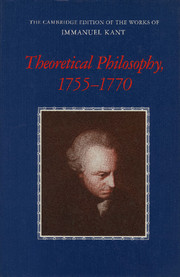Book contents
- Frontmatter
- Contents
- General editors' preface
- Preface
- Guide to abbreviations
- General introduction
- Introductions to the translations
- Résumés of the works
- A NEW ELUCIDATION OF THE FIRST PRINCIPLES OF METAPHYSICAL COGNITION (1755)
- THE EMPLOYMENT IN NATURAL PHILOSOPHY OF METAPHYSICS COMBINED WITH GEOMETRY, OF WHICH SAMPLE I CONTAINS THE PHYSICAL MONADOLOGY (1756)
- Preliminary considerations
- Section 1 Showing that the existence of physical monads is in agreement with geometry
- Section 2 Explaining the most general properties of physical monads
- AN ATTEMPT AT SOME REFLECTIONS ON OPTIMISM (1759)
- THE FALSE SUBTLETY OF THE FOUR SYLLOGISTIC FIGURES (1762)
- THE ONLY POSSIBLE ARGUMENT IN SUPPORT OF A DEMONSTRATION OF THE EXISTENCE OF GOD (1763)
- ATTEMPT TO INTRODUCE THE CONCEPT OF NEGATIVE MAGNITUDES INTO PHILOSOPHY (1763)
- INQUIRY CONCERNING THE DISTINCTNESS OF THE PRINCIPLES OF NATURAL THEOLOGY AND MORALITY (1764)
- M. IMMANUEL KANT'S ANNOUNCEMENT OF THE PROGRAMME OF HIS LECTURES FOR THE WINTER SEMESTER 1765 — 1766 (1765)
- DREAMS OF A SPIRIT-SEER ELUCIDATED BY DREAMS OF METAPHYSICS (1766)
- CONCERNING THE ULTIMATE GROUND OF THE DIFFERENTIATION OF DIRECTIONS IN SPACE (1768)
- ON THE FORM AND PRINCIPLES OF THE SENSIBLE AND THE INTELLIGIBLE WORLD [INAUGURAL DISSERTATION] (1770)
- Factual notes
- Bibliographies of editions and translations
- Glossary
- Biographical-bibliographical sketches of persons mentioned by Kant
- Index
Section 2 - Explaining the most general properties of physical monads
Published online by Cambridge University Press: 18 December 2014
- Frontmatter
- Contents
- General editors' preface
- Preface
- Guide to abbreviations
- General introduction
- Introductions to the translations
- Résumés of the works
- A NEW ELUCIDATION OF THE FIRST PRINCIPLES OF METAPHYSICAL COGNITION (1755)
- THE EMPLOYMENT IN NATURAL PHILOSOPHY OF METAPHYSICS COMBINED WITH GEOMETRY, OF WHICH SAMPLE I CONTAINS THE PHYSICAL MONADOLOGY (1756)
- Preliminary considerations
- Section 1 Showing that the existence of physical monads is in agreement with geometry
- Section 2 Explaining the most general properties of physical monads
- AN ATTEMPT AT SOME REFLECTIONS ON OPTIMISM (1759)
- THE FALSE SUBTLETY OF THE FOUR SYLLOGISTIC FIGURES (1762)
- THE ONLY POSSIBLE ARGUMENT IN SUPPORT OF A DEMONSTRATION OF THE EXISTENCE OF GOD (1763)
- ATTEMPT TO INTRODUCE THE CONCEPT OF NEGATIVE MAGNITUDES INTO PHILOSOPHY (1763)
- INQUIRY CONCERNING THE DISTINCTNESS OF THE PRINCIPLES OF NATURAL THEOLOGY AND MORALITY (1764)
- M. IMMANUEL KANT'S ANNOUNCEMENT OF THE PROGRAMME OF HIS LECTURES FOR THE WINTER SEMESTER 1765 — 1766 (1765)
- DREAMS OF A SPIRIT-SEER ELUCIDATED BY DREAMS OF METAPHYSICS (1766)
- CONCERNING THE ULTIMATE GROUND OF THE DIFFERENTIATION OF DIRECTIONS IN SPACE (1768)
- ON THE FORM AND PRINCIPLES OF THE SENSIBLE AND THE INTELLIGIBLE WORLD [INAUGURAL DISSERTATION] (1770)
- Factual notes
- Bibliographies of editions and translations
- Glossary
- Biographical-bibliographical sketches of persons mentioned by Kant
- Index
Summary
PROPOSITION IX. DEFINITION. Contact is the reciprocal application of the forces of impenetrability of several elements.
Scholium. Contact is commonly defined in terms of immediate presence. But even if you insisted on adding external (for without this addition, God, who is immediately present to all things, albeit internally present, would have to be thought of as touching them), the definition will hardly be thought to be complete in all respects. For since others have succeeded in satisfactorily establishing that bodies separated by empty space can nevertheless coexist and can therefore be immediately present to each other, though without reciprocal contact, this definition will doubtless be found to have its weaknesses. The Newtonian School, not without a great show of truth, defended the immediate attraction of bodies, even at a distance from each other, their co-presence, nonetheless, occurring in the absence of reciprocal contact. Furthermore, if one defends the definition which attempts to substitute immediate co-presence for the notion of contact itself, one ought first to explain the notion of this presence. If, as is usual, it is explained in terms of reciprocal action, in what, I ask, does the action consist? Undoubtedly, bodies act by moving each other. But the moving force, which is exerted from a given point, either repels other bodies from that point, or attracts them to it. It is obvious which of the two actions is to be understood as involved in contact. For, in moving one body closer and closer to another, we say that they are touching each other when the force of impenetrability, that is to say, of repulsion, is felt. Thus, the action and reaction of the different elements against each other constitutes the genuine notion of contact.
PROPOSITION X. THEOREM. Bodies would not have a determinate volume in virtue of the force of impenetrability alone; there must be another force, which is likewise inherent in them, the force of attraction. The two forces together define the limit of the extension of bodies.
The force of impenetrability is a repulsive force, which prevents anything external from approaching more closely.
- Type
- Chapter
- Information
- Theoretical Philosophy, 1755–1770 , pp. 60 - 66Publisher: Cambridge University PressPrint publication year: 1992



